Browse Houses
Search Results: Returned 5516 records. Displaying results 1 – 100
| House name | Description | |
|---|---|---|
| Clooncoe House | Lewis records "Brooklawn" as a seat of the O'Brien family in 1837. Brooklawn House in the townland of Clooncoo, parish of Cloone, was part of the Clements estate but is described at the time of the first Ordnance Survey as the seat of a Mr. Crawford. It is labelled Brooklawn on the 1st edition Ordnance Survey map but as Clooncoe House on all subsequent editions. It is still extant and occupied. |

|
| Hill House (Bandon) | William C. Sullivan was leasing this house from the Devonshire estate in 1851 when it was valued at £20. It is labelled Barrett's Hill House on the 1st edition Ordnance Survey map but as Hill House on the 25-inch edition of the 1890s. It does not appear to be extant now. | |
| Sriff Cottage | Sriff Cottage was associated with the Palmer family and possibily originally used as a hunting lodge. At the time of Griffith's Valuation, it was being leased from the Lane Fox estate by Henry Palmer and was valued at £4. This house is still extant and in 2015 was offered for sale. |
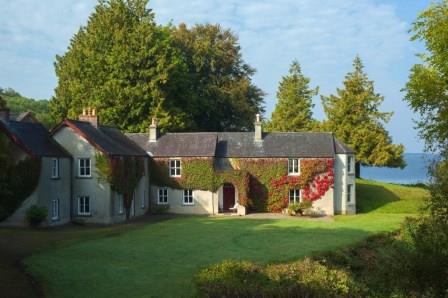
|
| ??? | ||
| Aasleagh Lodge | Documents in the Westport Estate Papers record the leasing of the fishing at Aasleagh 'Assdia' by the Viscounts Bourke of Mayo to the ffrench family of Galway in the 17th century. The 19th century lodge was let to the Honourable David Plunket in the 1850s. It was burnt down in 1923 but renovated and leased as a fishing lodge to various persons. It was let to Lord and Lady Brabourne, relatives of the Brownes of Westport, in the 1970s before its sale to the Fisheries Board. |
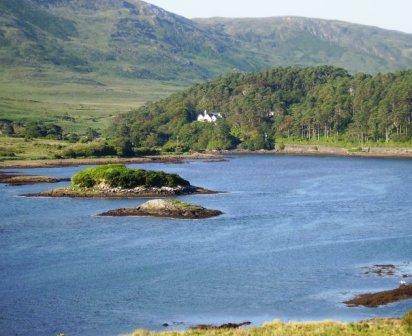
|
| Abberanville | Abberanville House is descibed as "in ruins" on the 1st edition OS map. The townland, containing 24 acres, was part of John B. Daly's estate and was leased to John Blake when the buildings were valued at £15s. The ruins of a hemp factory were located nearby. There are no buildings at the site now. | |
| Abbert | In 1786, Wilson refers to Abbert as the seat of Mr. Blakeney. Occupied by David Watson Ruttledge at the time of Griffith's Valuation when the buildings were valued at £35. Slater refers to Abbert as the seat of John Blakeney in 1894. A new house has been built at the site but the ruins of the original outbuildings still exist. |
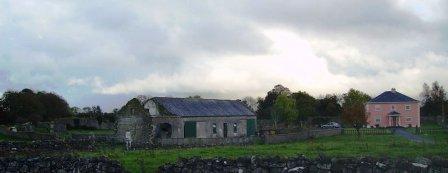
|
| Abbeville | Home of the Hemsworth family in the 18th and 19th centuries, occupied by Thomas Hemsworth in 1814. Thomas G. Hemsworth was resident in 1837 and in the early 1850s. Thomas George Hemsworth of Abbeville owned 387 acres in the 1870s. |
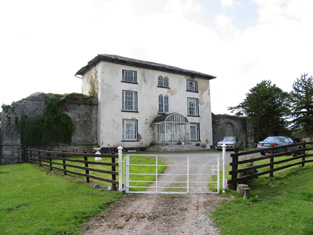
|
| Abbey Cottage | Rev, John Beecher was leasing this property, described as a herd's house, to Daniel Donovan, at the time of Griffith's Valuation, when it was valued at £7 15s. A house still exists at the site. | |
| Abbey Farm | A house built after the publication of the 1st edition Ordnance survey map, it was being leased by Henry Bannon from John Congreve's estate in 1849 when it was valued at £10. A house is still extant at the site. | |
| Abbey House | James Veale was leasing this property from the Congreve estate in 1849 when it was valued at £10. A house is still extant at the site. |
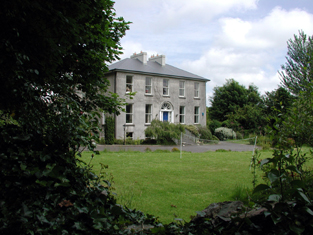
|
| Abbey House | George McNamara inhabited a house in the grounds of Cong Abbey in the 18th century but Sir William Wilde refers to only a fragment of this house remaining in 1867. Alexander Lambert also lived in a house in the Abbey grounds. Wilde describes this house as follows "More to the west there recently existed the residence of the late proprietor, A.C. Lambert Esq., constructed of the unhewn, weather-worn, but square stones, collected in the locality. Being no longer required, and not being quite congruous with the scene, it has been removed". The remains of this building are now used by the Board of Works. |
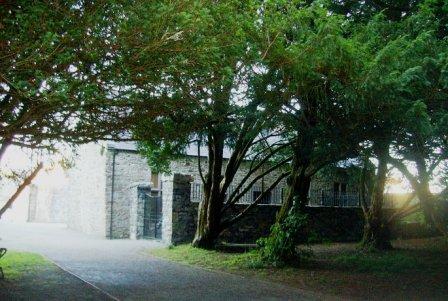
|
| Abbey View House | Morgan Crofton, agent to Lord Lorton, was residing here at the time of the first Ordnance Survey. At the time of Griffith's Valuation it was occupied by Caleb Robertson and valued at £34. A house is still extant at Abbey View. |

|
| Abbeyfield | A house in the town of Ennis, named Abbeyfield on the first Ordnance Survey map and Abbeyville by Samuel Lewis. In 1786 Wilson mentions that Lord Chief Justice Paterson had a residence in Ennis town. By the early 19th century it was being leased to Thomas Crowe. At the time of Griffith's Valuation the house was valued at £44 and was occupied by Wainwright Crowe who held it from Marcus Patterson. In the late 20th century it was used as a Garda station. |
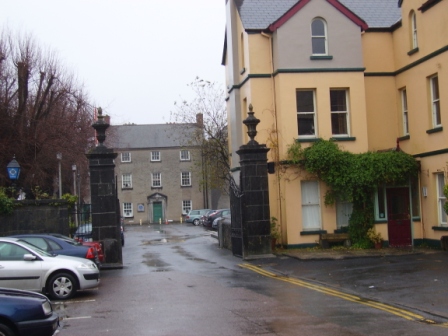
|
| Abbeyfield / Gortnagowth | In 1840 the Ordnance Survey Name Books refer to Abbeyfield House as the residence of William Jones. At the time of Griffith's Valuation, Jeremiah O'Brien was leasing this property from the Wall estate when it was valued at £15+ and included a mill. It is labelled Abbeyfield on the 1st edition Ordnance Survey map but as Gortnagowth on the 25-inch map of the 1890s. It is still extant. | |
| Abbeyland Cottage | A herd's house in the townland of Abbeyland Great, parish of Clonfert, barony of Longford, was part of Archdeacon Butson's estate. It was valued at £1 10 at the time of Griffith's Valuation and leased to John Kenny. This house is no longer extant. | |
| Abbeyland House | Archdeacon Butson was leasing a steward's house, valued at £8, in the townland of Abbeyland Great, parish of Clonfert, barony of Longford, to Allan Pollok, at the time of Griffith's Valuation. Buildings still exist at the site. | |
| Abbeylands | In 1906 L.T, Crosbie owned a property at Skrillagh, valued at £17. This townland also belonged to the Crosbie estate at the time of Griffith's Valuation, when it was let to the McElligott family. Bary states that the house, Abbeylands, was built in the 1870s as a residence for George Trench, agent to the Crosbie estate. In 1901 it was occupied by Ross Palmer and his family, JP for county Kerry and creamery owner. It was burnt in 1921 but restored later in the twentieth century and is now an ecumenical retreat centre. | |
| Abbeylands or The Abbey | Abraham Huggard was leasing this property from Sir William Godfrey at the time of Griffith's Valuation when it was valued at £5 10s. Local sources suggest it was built by the Huggard family in the early nineteenth century. It is still extant and occupied. | |
| Abbeytown | In 1906 Mrs. H. Campbell owned a property valued at £5 as well as over 100 acres of untenanted land at Abbeytown, [Grid reference is approximate] | |
| Abbeytown | The original historical abbey buildings in this townland are described as 'in ruins' at the time of the first Ordnance Survey. It was formerly the residence of a Mr Crofton but was then occupied by a caretaker for the Orme family. Abbeytown House is shown a litte to the north on the later 25-inch map of the 1890s. The property was bought by Anthony Carolan of Crossmolina at the sale in 1852 and the house was later lived in by the parish priest. Abbeytown is still extant and occupied. |
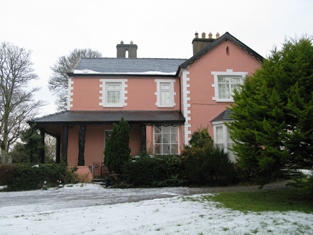
|
| AbbeyView | At the time of Griffith's Valuation, Alexander Phillips was leasing a house valued at almost £14 at Abbeyquarter North, barony of Carbury, from the Cooper estate. McTernan states that it was built in the later eighteenth century and described in 1878 "as a beautifully situated villa residence with attractive grounds". The Phillips family continued in residence until the 1860s after which it was occupied by a succession of owners until the 1990s when it was sold to the Electricity Supply Board who demolished the house. | |
| Abbeyville | Abbeyville was originally a Phibbs property. McTernan states that it was leased to William Fleming after the death of William Phibbs in 1785.The original house was built in 1716 but extensively modernised afterwards. In 1814 it was the residence of William Fleming. At the time of Griffith's Valuation it was being leased by James Fleming from William Phibbs and was valued at £6. In the later nineteenth century it passed out of the Fleming family. It was demolished in the later twentieth century. Leet indicates that Archibald Fleming resided at Larkfield, also close to Ballymote. | |
| Abbeyville | At the time of Griffith's Valuation this property was held in fee by Thomas H. Pilkington and valued at £7. It is still extant. |

|
| Abbeyville | A house located on the Finch estate and the home of the White family in the 19th century. Occupied by William White in 1814 and Richard White in 1837 and at the time of Griffith's Valuation when the buildings were valued at £26. Later the home of Henry Ievers, a younger brother of Robert Holmes Ievers, of Castle Ievers. The original house is not extant but a house still exists at the site. |
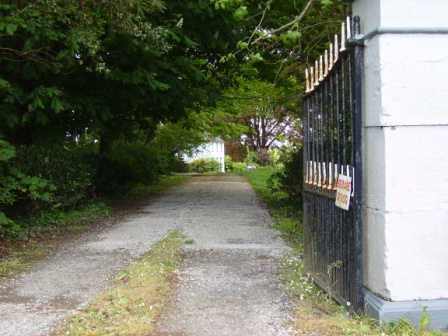
|
| Abington House | Abington House in the townland of Dromeliagh is marked on the first Ordnance Survey map. In 1786 Wilson states "at Abingdon, is a very pleasant seat of Sir Nicholas Lawless". At the time of Griffith's Valuation a house valued at £17 was occupied by Michael Apjohn in this townland. In the 1860s this house was occupied by John Connell Fitzgerald and his wife Margaret (Apjohn). ''The Limerick Chronicle'' of 1 Oct 1872 records the death of Mary Anne Apjohn of Abington House, widow of Michael Apjohn. The property was held from Lord Cloncurry. A ruined house is still extant at the site. |
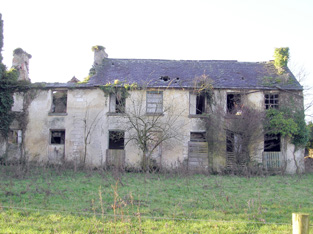
|
| Achonry House | John Docker was leasing Achonry House from the Armstrong estate at the time of Griffith's Valuation, when it was valued at £8. McTernan states that local tradition suggests the house was built by Docker when he leased the property from the Armstrongs. It was subsequently occupied, until the 1930s, by the Gorman family. It is still extant and has recently been renovated. | |
| Adare Manor | Early 18th century house replaced by a Tudor-Revivalist style building in the mid 19th century, the home of the Quin family and Earls of Dunraven. In 1786 Wilson describes the original house as "a very noble structure with fine and extensive demesnes". At the time of Griffith's Valuation valued at £130 and in 1906 the buildings at Adare Manor were valued at £182. Now functions as a hotel. |
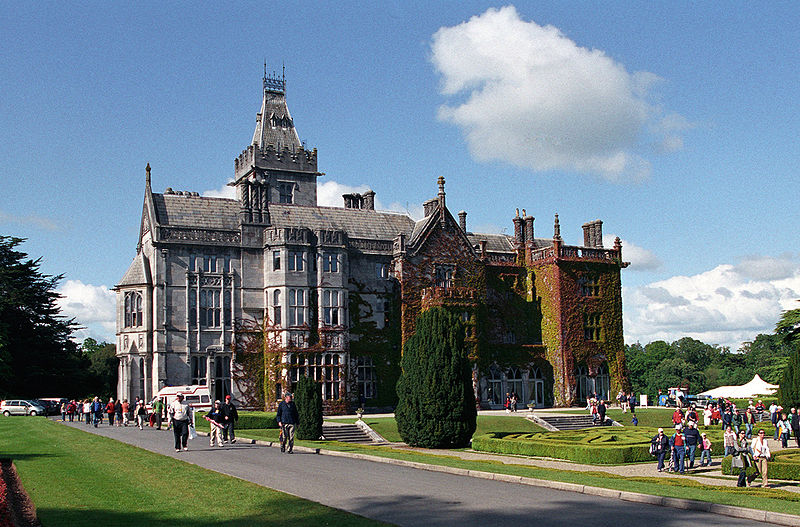
|
| Addergoole | Built in the late 1840s or early 1850s by Thomas Eastwood and later the location of the Kylemore farm buildings. |
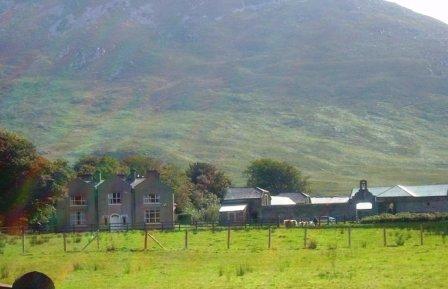
|
| Adelphi | A house on the Burton estate occupied by the Fitzgerald family and their descendants. The residence of Francis John Fitzgerald in 1814 and of F. and W. Fitzgerald in 1837. Valued at £30 at the time of Griffith's Valuation and occupied by Francis J. Fitzgerald, it passed by marriage to the Wilson-Fitzgerald family. This house was the home of Brian Blood in the mid 20th century. It is still extant. |
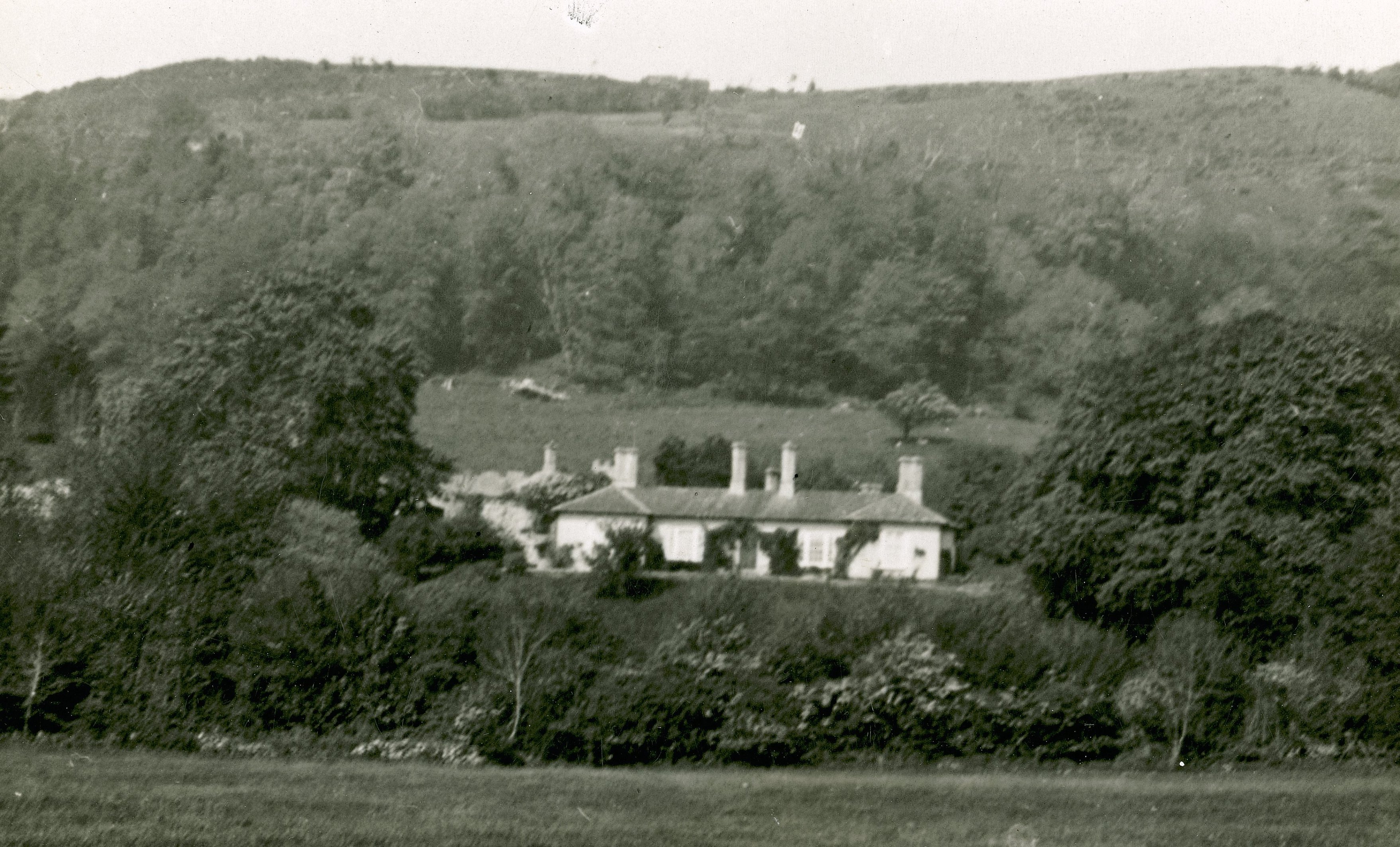
|
| Adrigole House | Rev. Richard Wright was leasing this property from the Bantry estate in 1852 when it was valued at £9. It is labelled Ardrigole Parsonage on the 1st edition Ordnance Survey map but appears as Adrigole House on the 25-inch edition of the 1890s. IN the early 1940s the Irish Tourist Association survey described it as "an old square building completely covered in ivy" and the property of a Mr. Crowley. It is still extant and has been offered for sale in recent years. | |
| Affane House | Held in fee by Samuel Browning Power in 1851 when it was valued at £32. Lewis refers to it as the seat of S. Power in 1837. It was the property of Samuel J. Power in 1906 and still valued at £32. Brady notes that the house incorporates material from the late seventeenth century house owned by the Greatrakes famly. In the 1780s Taylor and Skinner refer to it as a residence of the Browning family. It is now almost a ruin. |

|
| Aggard | In 1786 Wilson refers to Aggard as the seat of Mr. Lambert. In 1837 Lewis recorded Aggard as the seat of J. Lambert. The property at Aggard was being leased by the Lambert family from Reverend Thomas Kelly, at the time of Griffith's Valuation. Reverend Kelly's estate, including Aggard, was offered for sale in the Encumbered Estates court in February 1857. In 1894 the seat of J.W.H. Lambert. Aggard House is still extant and occupied. |
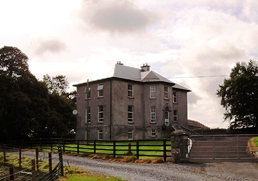
|
| Aghacashel | According to the National Inventory of Architectural Heritage Aghacashel House was built c. 1800. At the time of Griffith's Valuation it was occupied by Charles Rolleston and was valued at £14. In 1837 Lewis records it as a Johnston residence. In 1814 it was the home of Joseph Johnston. By 1906 it was still valued at £14 and was the property of Thomas Guckian. It is still extant. |
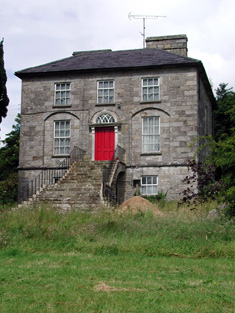
|
| Aghacross | Wilson, writing in 1786, refers to Aghacross as the seat of Mr. Anderson. No substantial residence is shown in this area on the 1st edition Ordnance Survey map. The townland was in the possession of William Anderson at the time of Griffith's Valuation. A modern farm exists at the site now. | |
| Aghada | J. Roche occupied this house in 1837. He built Aghada House and had a daughter who married [Henry] O'Brien of Whitepoint and they had a daughter who married her cousin William Roche. William Fitzgibbon was resident at Aghada House at the time of Griffith's Valuation when the house was valued at £35 and held from Henry O'Brien. It was the seat of William de Wilton R. Thackwell in 1894. http://www.archive.org/stream/barrymorerecords00barr/barrymorerecords00barr_djvu.txts | |
| Aghadoe Cottage | Archdeacon Forester was leasing Aghadoe Cottage from the Headley estate at the time of Griffith’s Valuation when it was valued at £7 10s. Bary states that it was built by the Archdeacon in 1838 though the Ordnance Survey Name Books mention him as being in residence there before that. It is still extant and is now run as Killeen House Hotel. See www.killeenhousehotel.com |
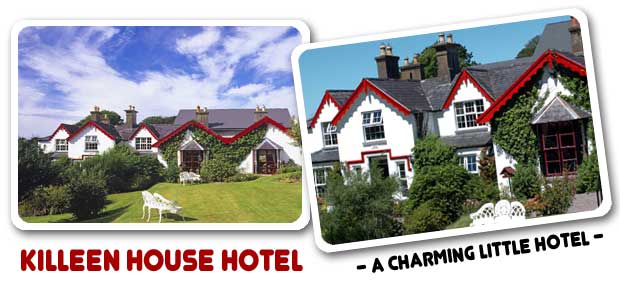
|
| Aghadoe House | Lady Headley was in possession of Aghadoe House at the time of Griffith’s Valuation when it was valued at £53. It is mentioned as " a very fine building, densely shaded with trees" in the Ordnance Survey Name Books of the 1830s. Bary, quoting the Name Books, states that it was built in 1828 at a cost of £12,000 though the National Inventory of Architectural Heritage states that it was probably redesigned in the 1860s. It was the seat of Lord Headley in 1894. The house was burnt in 1922 but re-built to the same plan. The Irish Tourist Association survey noted in 1943 that it was then the property of Robin Hilliard and was being extensively renovated. It is now the Killarney International Youth Hostel. |
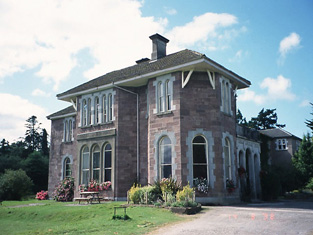
|
| Aghadoe House (Killeagh) | Lewis writes in 1837 that “The present house is about to be replaced by a castellated mansion”. The earlier house is referred to by Wilson in 1786 as the seat of Simon Dring. Aghadoe wasccupied by Thomas M. Green at the time of Griffith's Valuation. The house, valued at £27, was held by him from Sir Arthur De Capell Brooke. The house is no longer extant. | |
| Aghadown House | At the time of Griffith's Valuation, Aghadown House, owned by William Jago, was unoccupied and valued at £8. Lewis had noted Aghadown as the seat of H. Becher in 1837. [The 25" Ordnance Map shows a second house, also called at Aghadown House, at W049334] The original Aghadown House is shown on Taylor and Skinner's 1783 map as a seat of the Banfield family and Wilson refers to it as the seat of "Benjamin Bonsfield" in 1786. In the early 1940s the Irish Tourist Association survey noted that "of this mansion, one ivy-covered gable and the gazebo remain". The National Inventory of Architectural Heritage notes that the extant building may previously have been the steward's house when the original house was still occupied. |

|
| Aghafin House | Built close to the border with county Fermanagh in 1836 and extended in the early 20th century, this house valued at £24 was the home of a doctor, George Phillips, in the mid-19th century. George was a son of Thomas Phillips of Drumbrean House and held Aghafin from the Archbishop of Armagh. According to the ‘Northern Standard’ (2 January 1858) Thomas Phillips died at Aghafin on 28 December 1857, aged 82. George Phillips was living in Ontario, Canada, in 1875. In 1906, Mrs Madden was resident at Aghafin with a rateable valuation of £24. | |
| Aghagadda House | James O'Connell was in possession of this property, valued at £10 15s, at the time of Griffith's Valuation, when the house was vacant. In 1837 Lewis notes Ahadda as the seat of Rev. Mahony. Leet refers to Richard Mahony residing at Portmagee in 1814. Bary states that the house was built by the Mahonys who resided there in the early nineteenth century. It seems to have become the home of Charles O'Connell, son-in-law of Daniel O'Connell, for a time in the 1850s. Later it was occupied by members of the Spotswood family of Valentia. It is now a ruin. | |
| Aghamarta Castle | This property was held in fee by the representatives of Carew O'Grady at the time of Griffith's Valuation, when it was valued at £22. Lewis noted it as the seat of Carew O'Grady in 1837. Local sources suggest that he had purchased it, c.1824, from the Pomeroy family, who had purchased it from the Earl of Shannon in the later seventeenth century. The original castle was replaced by the existing house in the 1830s. The property is now a farm and cookery school. See www.thompsonsfarmshop.com |
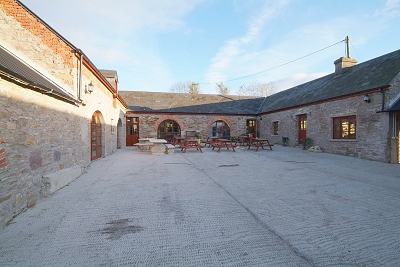
|
| Aghamore House | Russell B. Cameron was leasing this property from the Crofton estate at the time of Griffith's Valuation when it was valued at £12. A house is still extant though not on the original site. | |
| Aghanboy | Mary Bourke was leasing this property valued at £5 from Col. Thomas Bourke at the time of Griffith's Valuation. It is not named on the 1st edition map though buildings are shown. Leet records Ahanebee as the seat of Captain Burke in 1814. Buildings are still extant at the site. | |
| Aghangran House | Joseph Dexter was leasing this property from the Blacker estate at the time of Griffith's Valuation, when it was valued at £4. Leet recorded it as the seat of Thomas O'Connor in 1814. In 1837 Lewis mentions the house as the residence of J. O'Connor. The Ordnance Survey Name Books mention that John O'Connor was leasing the property from Maxwell Blacker in the 1830s. Bary notes that the house was associated with the O'Connor family earlier in the nineteenth century. It was later burned and subsequently demolished. | |
| Aghavine | Occupied by Michael Neville in the early 1850s, held from Francis Wyse and valued at £20. |
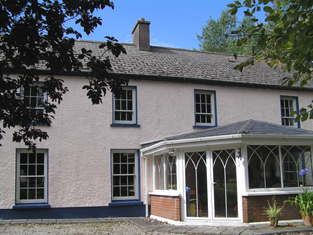
|
| Aghavrin House | This house was the home of the Crooke family for much of the 19th century, occupied in 1837 by Captain T. E. Crooke and at the time of Griffith's Valuation by William Crooke. The house was valued at £26 and held from John B. Gumbleton. The Irish Tourist Association Survey of the 1940s refers to it as the residence of Mrs. Scott, nee Crooke, by whose family the house was built. It also rather quaintly notes that “During the troubles of 1919-1921, the IRA often billeted themselves on the premises without any special invitation from the owner”. Aghavrin is still extant and occupied. |
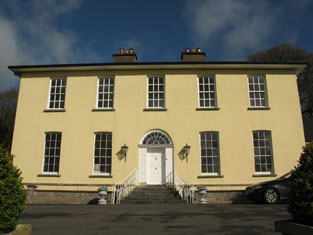
|
| Agheralane | Both Lewis and Griffith’s Valuation record Agheralane as the residence of Thomas Lucas. It was valued at £28 and held from Joseph Griffith. Occupied by John and Emily Adams at the beginning of the 20th century. The buildings were laid out in a square. | |
| Aghern/Ahern House | Brabazon Esq was resident in the 1770s and 1780s. The home of Spotswood Bowles in the first half of the 19th century. The buildings were valued at £47+ in the early 1850s and held from the representatives of William Beamish. Spotswood died in 1864 and was succeeded by his son George who was in turn succeeded by his nephew Spotswood in 1886. Relatives of the Bowles owned this property until the 1970s. In 1942 the Irish Tourist Association Survey mentions the ruins of Aghern Castle in the grounds of Mrs. Spotswood Bowles property. Aghern was uninhabited for a time but has recently been restored. |

|
| Aghnamallagh House | James A. Mayne lived in this house in the mid-19th century. He held it in fee and the buildings were valued at £22. This was the home of the Elliot family in the early 20th century. The house is still extant. see https://www.geograph.ie/photo/897268 | |
| Aghrane Castle/Castle Kelly | A 16th century tower house with 19th century additions. Castle-Kelly is recorded by Wilson as the seat of Denis Kelly in 1786. Lithographs of the entrance to Castle Kelly, Castle Kelly and Ballygar town are included in the sales rental of 1863. It was bought by the Bagots, sold by them to the Department of Agriculture in 1910 and demolished in 1919. Parts of the demesne are now owned by Coillte, the Forestry Service. |
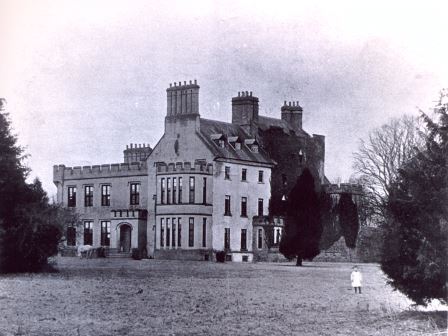
|
| Aghsmear | This house is not marked on the first edition Ordnance Survey map. Griffith's Valuation records a house of £4.5 shillings valuation occupied by Dr Patrick Cleary and held from Joseph Griffith. Joseph Griffith lived at Aghsmear in the 1870s and he was still resident in 1906 when the mansion house was valued at £22+. |
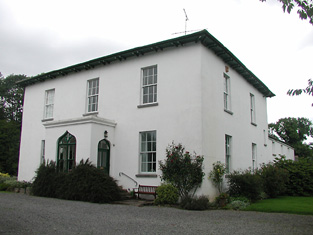
|
| Aglish | The Hingstons were resident at Aglish from the early 18th century. At the time of Griffith's Valuation James Hingston owned a house valued at £21 in fee. An "old mansion house" is marked on the first Ordnance Survey map at the Grid Reference W469715. The current Aglish House was built after that and appears on the 25-inch map of the 1890s. It is still extant. | |
| Aglish House (Decies) | Aglish House was leased by James O'Brien from the representatives of James Nagle, in 1851, when it was valued at almost £14. It is still extant and occupied. |
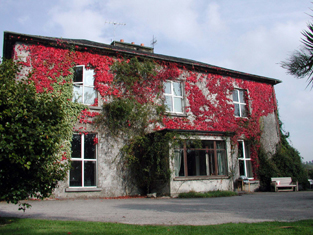
|
| Ahabeg | Built in 1827 this house was the home of the Rose family in the 19th century. It was occupied by Michael Lloyd who held it from Counsellor Richard Rose circa 1840. The residence of Richard Rose held by him in fee at the time of Griffith's Valuation and valued at £18+. Aghabeg is still extant and well-maintained. | |
| Ahalisky | William Bence-Jones held this property in fee at the time of Griffith's Valuation when it was valued at £14. A plant nursery is identified at this location on the 1st edition Ordnance Survey map. Extensive farm buildings occupy the site now. | |
| Ahanesk | A house on the shore of Cork Harbour occupied by William Oliver Jackson at the time of Griffith's Valuation and held by him in fee. It was valued at £24. In 1906 a mansion house in the townland of Ballyvodock East was valued at £98. The house passed by marriage to the Sadlier Jackson family and in the mid 20th century became the home of the Lomers. |
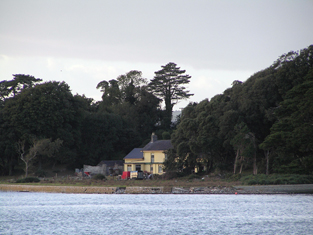
|
| Ahascragh Glebe/Rectory | At the time of Griffith's Valuation, Rev. Sir William Mahon was leasing a house valued at £20 in the townland of Ahascragh West, barony of Kilconnell, to Reverend Peter Browne. He was also leasing property in this townland to Thomas Hunt. Reverend Mahon was rector of Rawmarsh, Yorkshire. This property is still extant and occupied as a private house. |
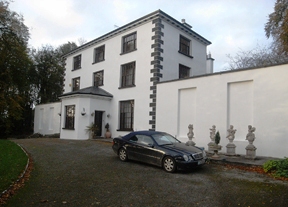
|
| Aherla | Occupied by the Reverend John Madras at the time of Griffith's Valuation and held from Richard Goode, the buildings were valued at £11.10 shillings. | |
| Aherla Cottage | A residence valued at £11 and held by William Good in fee at the time of Griffith's Valuation. | |
| Aherlow Castle | This early 19th century building was the residence of James A. Butler in the 1830s. In 1840 the Ordnance Survey Name Books note that it was the residence of the parish priest of Templeneiry. The Reverend William Kane was resident in the early 1850s when the buildings were valued at £9.15 shillings and held from James A. Butler. Aherlow Castle was later the property of the Moores of Mooresfort. Count Charles Moore was the occupier in 1906 when the buildings were valued at £20. It is now a ruin. |

|
| Ahnagurra | Ahnagurra was the residence of Thomas T. Adams in 1837 and at the time of Griffith's Valuation, when the buildings were valued at £26. He held the property from Francis Coppinger. | |
| Airhill | The home of the Green family for over two centuries, occupied by Colonel H. G. Barry in 1814 and by James Greene at the time of Griffith's Valuation. James Greene held the property from Francis Wyse. The buildings were valued at £20. This house is still a family home. | |
| Albano Cottage | At the time of Griffith's Valuation, Rev. Peter Daly was leasing this property from James Browne when the buildings were valued at £9. It is still extant and occupied. | |
| Albert Villa | Occupied by William Finch at the time of Griffith's Valuation and valued at £31. Described in 1856 as a large mansion house, "erected by the late Mr Shannon" and occupied by John C. Drysdale. By the 1890s this house is labeled "Lanahrone" on the 25-inch Ordnance Survey map. It is no longer extant and a modern housing estate now occupies the site. | |
| Alderford | At the time of Griffith's Valuation Alderford was leased by the representatives of William F. McDermottroe to Catherine Thompson and was valued at £25. In 1814 it was the seat of Thomas McDermottroe. Lewis also records it as the seat of the latter in 1837. Alderford is famous for its associations with Turlough O'Carolan, the Irish harper, as he died there in 1738 and is buried nearby in Kilronan. This house, however, was built in the early 19th century. It was the seat of Thomas Charles McDermottroe in 1894. It is still extant but in a dilapidated condition. |

|
| Aldworth | Hajba writes that this house was occupied by members of the Bolster family who held it from the Newmans in the late 18th century. It then became a Lombard property and passed from them to a relative, James Hunt. In the early 1850s it was occupied by James Laurence Cotter, held from James Hunt and valued at £14. This house is still occupied. Another house close by named Aldworth Lodge was also a Bolster home valued at £4+ at the time of Griffith's Valuation. A house is also extant at the latter site. |

|
| Alloonbaun/Church View | At the time of Griffith's Valuation Rev. Joseph Seymour was leasing this house from the Clancarty estate when it was valued at almost £8. It is still extant and occupied. |
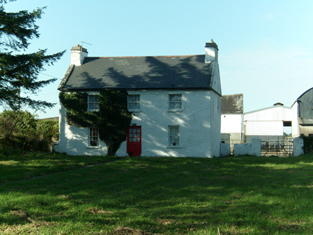
|
| Allowdale | A house valued at almost £12 in the mid 19th century, held by Daniel McCabe from the Earl of Egmont, now a ruin. | |
| Alta Villa | The home of a branch of the Going family for much of the 19th century. Charles Going was resident in 1814, William Going in 1837. The Ordnance Survey Name Books describe it as "of modern structure in good repair" in 1840. William Going was also the occupier at the time of Griffith's Valuation when the house was valued at £22+ and his flour mill at £66. The property was held from the representatives of Dunbar Barton. Alexander Going of Alta Villa owned 313 acres in county Tipperary in the 1870s. Sir T. Warren lived at Alta Villa, Cahir in the mid 20th century. Alta Villa is still extant and occupied. |
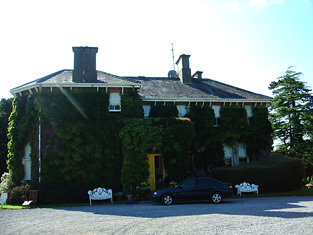
|
| Altaghaderry | Alexander Maxwell was leasing this property from the estate of Robert McClintock at the time of Griffith’s Valuation, in the 1850s, when it was valued at £10. Modern buildings are visible at the site now. | |
| Altamenagh | At the time of Griffith’s Valuation, William H. Foster was leasing a house at Ballynakillew Mountain from the Provost and Fellows of Trinity College estate. It was valued at over £10. This appears to be the house labelled Altamenagh on later editions of the 6-inch Ordnance Survey map. It is no longer extant. | |
| Altamira | Originally a Smyth house, Altamira became the home of the Purcell family in the late 18th century and remained in their possession for about a century. Occupied by William Purcell in 1814 and 1837 and by his nephew Pierce Purcell at the time of Griffith's Valuation. Pierce held the property from the Earl of Bandon and Lady O'Brien. The house was valued at £34. In the 1940s the Irish Tourist Association Survey noted that Altamira was then the residence of the Hannigan family. |
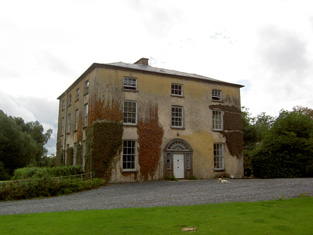
|
| Altamont Villa | A Browne house described in the 1830s as a slated house with 2 stories at the rear. Also known as Mallow Cottage and possibly New Brighton Lodge, it was leased by the 2nd Marquess of Sligo to Neal Davis in the late 1830s. Sold to William O'Brien, whose widow left it to the Convent of Mercy. | |
| Altanelvick | A summer residence of the Jones family of Benada. In 1857 held in fee by Daniel Jones and valued at £3. The house became derelict in the twentieth century but has since been restored. | |
| Altaskin Lodge | Robert Rankin was leasing this property from the Ecclesiastical Commissioners estate at the time of Griffiths Valuation in the 1850s, when it was valued at £16. | |
| Altavilla | Bence Jones writes that this house was built by the Bateman family in the mid 18th century to the design of Francis Bindon. In 1786 Wlson refers to it as the seat of Jon Bateman. The Ordnance Survey Name Book records that Altaville House was a rectangular building of four storeys built in 1749 by Mr Bateman and that it was then [circa 1840] undergoing repairs by Peter Griffin of Corgrieff. At the time of Griffith's Valuation it was inhabited by Peter Griffin who had carding mills and offices closeby. He held the property from William Dickson. It is still extant. |

|
| Altavilla | Robert Rae was the owner of this property at the time of Griffith's Valuation, when it was valued at £5 5s. It is named as Altavilla on the 1st edition Ordnance Survey map. In 1837 Lewis refers to Ardmoniel Cottage, the seat of R. Rae, but also to Altavilla, residence of J. Morrogh. Bary mentions that Altavilla was associated with the Morrogh family. It was later the residence of the Dodd family and is still extant. |

